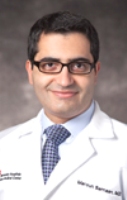Aug 8 2014
University Hospitals (UH) Case Medical Center is the first in Cleveland to implant a new type of cochlear device for adults who have lost the high frequency range of their hearing, but have retained the low frequencies with or without a hearing aid.
 Maroun Semaan, MD, ear, nose, and throat surgeon at University Hospitals Case Medical Center, became the first surgeon in Cleveland, Ohio, to implant the L24 hybrid cochlear system.
Maroun Semaan, MD, ear, nose, and throat surgeon at University Hospitals Case Medical Center, became the first surgeon in Cleveland, Ohio, to implant the L24 hybrid cochlear system.
The surgery, which took about two hours, was performed on July 31 by
Maroun Semaan, MD, an otolaryngologist (ear, nose and throat surgeon) at UH Case Medical Center on a male in his 60s who had some hearing in lower frequencies but who had lost hearing in high frequencies and found no help with hearing aids.
“This is a hybrid implant in that it has an acoustical component that can provide sound amplification for the preserved lower frequency hearing and an electronic component that stimulates the acoustic nerve electrically to pick up the high frequencies,” said
Dr. Semaan, who is Associate Director, Otology, Neurotology, and Balance Disorders at UH Case Medical Center, and Assistant Professor, Otolaryngology at Case Western Reserve University School of Medicine.
The implant, called the Nucleus Hybrid L24 Cochlear Implant System, received U.S. Food and Drug Administration (FDA) approval in the spring of this year. It has been implanted at only a handful of medical centers in the nation.
The loss of high frequency hearing usually occurs when there is damage to the inner ear (cochlea). It may be caused by aging, heredity, exposure to loud noise, drugs, such as antibiotics, that are toxic to the inner ear, and certain other illnesses. People with severe or profound hearing loss of high-frequency sounds may have difficulty hearing faint sounds, understanding people with higher-pitched voices, hearing certain speech sounds, and, in some cases, hearing high-pitched emergency vehicle sirens or common safety alarms, such as smoke detectors.
“Hearing loss greatly impacts the quality of a patient’s life,” said Dr. Semaan. “When compared to the benefits provided by conventional cochlear implantation, the hybrid implant device may enhance the sound richness and quality, music appreciation, and improve hearing in noise.”
Dr. Semaan and the cochlear implant audiologists at UH will know how well the device is working in the patient in about six to eight weeks when the device is turned on.
“Many patients who have been frustrated with their hearing aid performance, but had too much low frequency hearing to qualify for a cochlear implant, may now qualify for the hybrid implant,” said Gail Murray, PhD, Director of the Audiology and Cochlear Implant Center at UH Case Medical Center and Associate Professor, Otolaryngology at Case Western Reserve University School of Medicine. “These patients actually will receive the ‘best’ that both technologies have to offer; low frequency acoustic hearing from the hearing aid component and high frequency hearing from the electric cochlear implant stimulation.”
UH Case Medical Center anticipates performing five to 10 implants annually.
The risks are the same as a conventional cochlear implant, said Dr. Semaan, with the additional 30 percent risk of losing hearing the in the low frequency range.
L24 system consists of an external microphone and speech processor that picks up sounds from the environment and converts them into electrical impulses. The impulses are transmitted to the cochlea through a small bundle of implanted electrodes, creating a sense of sound that the user learns to associate with the mid- and high-frequency sounds they remember. The hearing aid portion of the device is inserted into the outer ear canal like a conventional hearing aid, and can amplify sounds in the low-frequency range.
The implant is manufactured by Cochlear Ltd., headquartered in New South Wales, Australia.